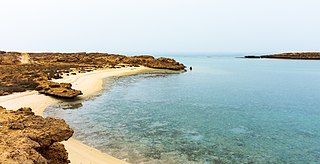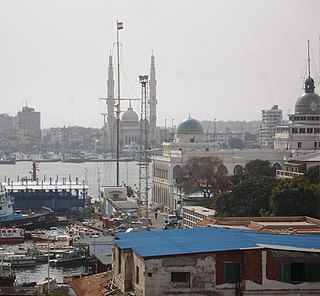
The Red Sea is a sea inlet of the Indian Ocean, lying between Africa and Asia. Its connection to the ocean is in the south, through the Bab-el-Mandeb strait and the Gulf of Aden. To its north lie the Sinai Peninsula, the Gulf of Aqaba, and the Gulf of Suez. It is underlain by the Red Sea Rift, which is part of the Great Rift Valley.

The Sinai Peninsula, or simply Sinai, is a peninsula in Egypt, and the only part of the country located in Asia. It is between the Mediterranean Sea to the north and the Red Sea to the south, and is a land bridge between Asia and Africa. Sinai has a land area of about 60,000 km2 (23,000 sq mi) and a population of approximately 600,000 people. Administratively, the vast majority of the area of the Sinai Peninsula is divided into two governorates: the South Sinai Governorate and the North Sinai Governorate. Three other governorates span the Suez Canal, crossing into African Egypt: Suez Governorate on the southern end of the Suez Canal, Ismailia Governorate in the center, and Port Said Governorate in the north.

The Suez Canal is an artificial sea-level waterway in Egypt, connecting the Mediterranean Sea to the Red Sea through the Isthmus of Suez and dividing Africa and Asia. The 193.30-kilometre-long (120.11 mi) canal is a key trade route between Europe and Asia.

The Suez Crisis or the Second Arab–Israeli War, also referred to as the Tripartite Aggression in the Arab world and as the Sinai War in Israel, was a British–French–Israeli invasion of Egypt in 1956. Israel invaded on 29 October, having done so with the primary objective of re-opening the Straits of Tiran and the Gulf of Aqaba as the recent tightening of the eight-year-long Egyptian blockade further prevented Israeli passage. After issuing a joint ultimatum for a ceasefire, the United Kingdom and France joined the Israelis on 5 November, seeking to depose Egyptian president Gamal Abdel Nasser and regain control of the Suez Canal, which Nasser had earlier nationalised by transferring administrative control from the foreign-owned Suez Canal Company to Egypt's new government-owned Suez Canal Authority. Shortly after the invasion began, the three countries came under heavy political pressure from both the United States and the Soviet Union, as well as from the United Nations, eventually prompting their withdrawal from Egypt. Israel's four-month-long occupation of the Egyptian-occupied Gaza Strip and Egypt's Sinai Peninsula enabled it to attain freedom of navigation through the Straits of Tiran, but the Suez Canal itself was closed from October 1956 to March 1957. The Suez Crisis led to international humiliation for the British and the French in the wake of the Cold War, which established the Americans and the Soviets as the world's superpowers. It also strengthened Nasser's standing.

Port Said is a city that lies in northeast Egypt extending about 30 km (19 mi) along the coast of the Mediterranean Sea, straddling the west bank of the northern mouth of the Suez Canal. It forms the majority of the Port Said governorate, where its seven districts comprise seven of the governorate's eight regions. The city was established in 1859 during the building of the Suez Canal, and at the beginning of 2023 had a population of 680,375 people.

Barthélemy-Prosper Enfantin was a French social reformer, one of the founders of Saint-Simonianism. He was also a proponent of a Suez canal.

Suez is a seaport city in north-eastern Egypt, located on the north coast of the Gulf of Suez on the Red Sea, near the southern terminus of the Suez Canal, and is the capital of the Suez Governorate. It has three ports: the Suez Port, al-Adabiya, and al-Zaytiya, and extensive port facilities. Together they form a metropolitan area, located mostly in Africa with a small portion in Asia.

Ferdinand Marie, Comte de Lesseps was a French diplomat and later developer of the Suez Canal, which in 1869 joined the Mediterranean and Red Seas, substantially reducing sailing distances and times between Europe and East Asia.

Port Said Governorate is a subdivision located at the northeast end of the Nile Delta, on the coast of the Mediterranean Sea at the northern mouth of the Suez Canal. It is wholly urban, comprising the original Port Said city on the west bank of the Suez Canal, and the town of Port Fuad on the eastern bank.

Nikolaus Alois Maria Vinzenz Negrelli, Ritter von Moldelbe was a Tyrolean civil engineer and railroad pioneer mostly active in parts of the Austrian Empire, Switzerland, Germany and Italy.

The Suez Company or Suez Canal Company, full initial name Compagnie universelle du canal maritime de Suez, sometimes colloquially referred to in French as Le Suez, was a company formed by Ferdinand de Lesseps in 1858 to operate the Egyptian granted concession of the Suez Canal, which the company built between 1859 and 1869. Initially, French investors held half of the Company's stock, with Egypt's ruler Sa'id Pasha holding most of the balance. In 1875, financial distress forced Sa'id's successor Isma'il Pasha to sell the country's shares to the government of the United Kingdom. The Suez Company operated the canal until Egypt's new president Gamal Abdel Nasser revoked its concession in 1956 and transferred canal operation to the state-owned Suez Canal Authority, precipitating the Suez Crisis.

Port Fuad or Port Fouad is a city in Port Said Governorate, Egypt. Port Fuad is located in northeastern Egypt at the northwesternmost tip of the Sinai Peninsula on the Asian side of the Suez Canal, across from the city of Port Said. Port Fuad is considered a suburb of Port Said and together they form a metropolitan area of over one million residents. Along with the likes of Colón, Panama and Istanbul, Turkey (Asia/Europe), it is one of the few transcontinental cities in the world, in that spans it across two continents.
Suez is a seaport town in north-eastern Egypt.

The Canal of the Pharaohs, also called the Ancient Suez Canal or Necho's Canal, is the forerunner of the Suez Canal, constructed in ancient times and kept in use, with intermissions, until being closed in 767 AD for strategic reasons during a rebellion. It followed a different course from its modern counterpart, by linking the Nile to the Red Sea via the Wadi Tumilat. Work began under the pharaohs. According to Darius the Great's Suez Inscriptions and Herodotus, the first opening of the canal was under Persian king Darius the Great, but later ancient authors like Aristotle, Strabo, and Pliny the Elder claim that he failed to complete the work. Another possibility is that it was finished in the Ptolemaic period under Ptolemy II, when engineers solved the problem of overcoming the difference in height through canal locks.

Lake Timsah, also known as Crocodile Lake ; is a lake in Egypt on the Nile delta. It lies in a basin developed along a fault extending from the Mediterranean Sea to the Gulf of Suez through the Bitter Lakes region. In 1800, a flood filled the Wadi Tumilat, which caused Timsah's banks to overflow and moved water south into the Bitter Lakes about nine miles (14 km) away. In 1862, the lake was filled with waters from the Red Sea, and became part of the Suez Canal.

The Egyptian Department of Public Works was established in the early 19th century, and concentrates mainly on public works relating to irrigation and hydraulic engineering. These irrigation projects have constituted the bulk of work performed by this entity in Egypt. During its almost 200-year history, the Egyptian Department of Public Works employed many notable engineers and constructed massive public works projects throughout the country. It became the most respected engineering entity and was regarded as the 'best school' for civil engineers in modern Egypt. Its history can be broken into three periods:
- The Classic Period (1818–1882).
- The Occupation Period (1882–1952).
- The Modern Period.

The history of Egypt under the British lasted from 1882, when it was occupied by British forces during the Anglo-Egyptian War, until 1956 after the Suez Crisis, when the last British forces withdrew in accordance with the Anglo-Egyptian agreement of 1954. The first period of British rule (1882–1914) is often called the "veiled protectorate". During this time the Khedivate of Egypt remained an autonomous province of the Ottoman Empire, and the British occupation had no legal basis but constituted a de facto protectorate over the country. Egypt was thus not part of the British Empire. This state of affairs lasted until 1914 when the Ottoman Empire joined World War I on the side of the Central Powers and Britain declared a protectorate over Egypt. The ruling khedive, Abbas II, was deposed and his successor, Hussein Kamel, compelled to declare himself Sultan of Egypt independent of the Ottomans in December 1914.
The High-speed railway to Eilat (Med-Red) is a proposed Israeli railway that will enable the connection of the main Israeli population centers and Mediterranean ports to the southern city of Eilat on the Red Sea coast, as well as serve commercial freight between the Mediterranean Sea and Red Sea (Eilat). The railway will spur southward from the existing rail line at Beersheba, and continue through Dimona to the Arava, Ramon Airport and Eilat, at a speed of 350 kilometers per hour (220 mph). Its length will be roughly 260 km (160 mi) of electrified double-track rail. Currently Dimona railway station is the southernmost passenger train station in Israel and the one with the least boardings/alightings.
The Suez Canal Corridor Area Project is a megaproject in Egypt that was launched on 5 August 2014 by President Abdel Fattah el-Sisi and was completed in 2015. The project aimed to increase the role of the Suez Canal region in international trade and to develop the canal cities of Suez, Ismailia, and Port Said.
The following is a timeline of the history of the city of Port Said, Egypt.















